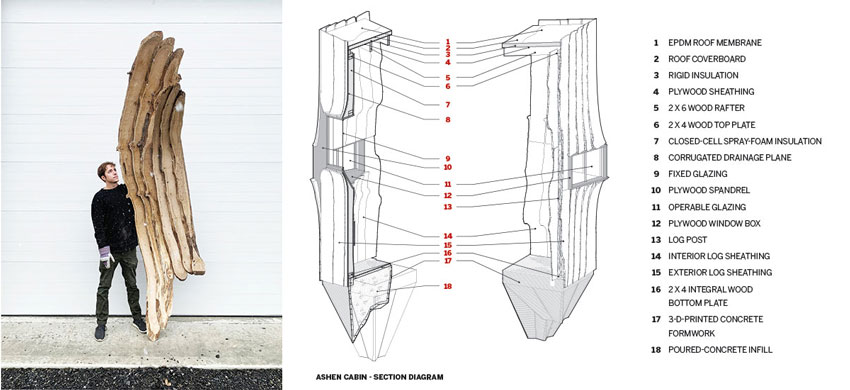Bio-Based Materials
The designers developed the initial scheme around a set of ash trees’ typical irregularities—for example, forks and bends—organizing these features to highlight such architectural moments as windows, downspout, and door. The project’s crew then headed out into the forest, selected and scanned their lumber, and the designers refined the scheme in response to the specific potential of the chosen wood. “It’s very different from the conventional method of making a design that you give to the contractor, who then builds what you drew,” says Lok. “There is a reciprocity between the design intent and what the raw material can offer.”

PHOTOGRAPHY: © ANDY CHEN
3-D LASER SCANNING and robotics-based manufacturing techniques helped HANNAH Architecture and Design create the 100-square-foot Ashen Cabin (opposite and above) in upstate New York from trees killed by the emerald ash borer.
A process that responds to the uniqueness of organic, found materials might seem to have limited application to the massive scale of both the ash borer catastrophe and the contemporary construction industry. But the integration of laser scanning, robotic milling, and more advanced computational protocols make it conceivable to inventory and digitize an entire forest, says Zivkovic, so architects can know exactly what kind of tree is available to them. “We can actually mass customize,” he says.
It’s also an option to adapt the fabrication method to produce conventional materials, such as glulam, cross-laminated timber, and laminated-veneer lumber. The sheer quantity of dying ash would justify these more standardized uses, but Lok and Zivkovic hope for a middle ground, where the unique characteristics of the material remain legible. “Rather than processing a tree into a standardized material that then gets customized again through design,” they say, “we’re interested in how the idiosyncrasies of the material push for a new architectural expression.”
While bio-based products such as cork blocks and robotics-enabled ash panels have significant, perhaps revolutionary, implications for architectural expression, others are ready to substitute directly for conventional counterparts. For example, a four-year research project sponsored by the European Union’s Horizon 2020 program, called ISOBIO, concluded in 2019 with the launch of three new low-impact alternatives for common building products.

IMAGES: COURTESY HANNAH
THE WOOD COMPONENTS of Ashen Cabin have been designed to take advantage of the irregular geometries typical of ash trees, including forks and bends.
They include an insulation board, consisting of hemp and a bio-based binder; an insulating lime stucco that uses a high proportion of hemp shiv (the chopped up, woody core of the plant, also known as shives or hurds) as its aggregate; and an insulating and fire-protective clay plaster (incorporating hemp powder) with enhanced moisture-buffering properties. In addition to their stand-alone functionality, these innovative materials have been combined into a composite panel that can be used either as a building envelope in new construction or as an external or internal retrofit. The embodied emissions of the structural panel, at 27.5 kgCO2e/m2, amount to about a quarter of those of a standard new exterior wall; taking into account the atmospheric carbon stored in the panel’s biogenic material would make it carbon-negative.
A related product, hempcrete, is a biocomposite of hemp shiv mixed with a lime-based binder and water. It can be either poured or cast into blocks to form an insulative, non-structural wall. In the United States, since the Industrial Hemp Farming Act of 2018 removed the eponymous plant from the list of controlled substances, hopes for reliable, commercial-scale production of hempcrete are growing.
Meanwhile, a recently completed facility2 in California is expected to begin using rice straw to manufacture medium density fiberboard (MDF) later this year. Rice straw–based MDF upcycles an abundant agricultural waste material, the stems and leaves left behind when the grain is harvested, previously disposed of by burning, and now commonly flooded to speed decomposition. According to the manufacturer, rice straw is in some ways even better suited to MDF than wood: its curling shape and natural waxes make for a stronger panel with better moisture resistance, and it certainly grows faster.









